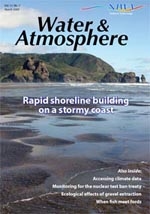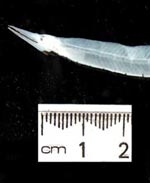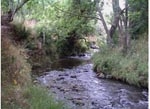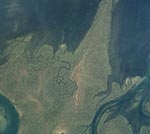PDF of this article (303 KB)

Strange larval eel caught by Tangaroa

Eels have a worldwide distribution, and there are 720 species of ‘true eels’, or Anguilliformes. Almost all of these species are marine; for example there are over 130 species of conger eels, 170 of moray eels, and 250 of worm eels. Worldwide, there are 15 species of freshwater eel, Anguilla, 3 of which are known from New Zealand. The most widespread of these, the endemic longfin eel (Anguilla dieffenbachii), is the only species for which marine larvae have never been collected. Accordingly, the spawning grounds of the longfin eel are unknown, although the recent discovery of a pop-up tag off New Caledonia is the first evidence that this species spawns in the tropics.
During a recent Tangaroa voyage to the west and north of New Zealand to collect rock lobster larvae, scientists also preserved any eel larvae – leptocephalii – for identification. Leptocephalii are leaf shaped, presumably because this shape enables them to be more easily transported by ocean currents. A total of 164 eel larvae was caught on the voyage, but unfortunately none of them were freshwater eels – most were larvae of a small species of conger.
However, the collections did contain one very unusual specimen. Measuring 375 mm long, it was identified as Leptocephalus giganteus, literally the giant leptocephalus. This is a member of the ‘spiny eel’ group (not a true eel), but is known from only a few larvae specimens. Most of these have come from the Southern Ocean, with the largest being a massive 1.5 m long. Adults of this species are unknown, but writers have speculated that if the adult-to-larva ratio were similar to that of freshwater eels (a 10 x increase), then the adult of this giant larva could be as long as 20 m! However, this seems very unlikely, and there is evidence that for some species with particularly large larvae (like Leptocephalus giganteus), the adults are actually smaller than the juveniles.
Thanks to the crew and science staff of Tangaroa, especially Helen Neil and Phil Sutton, for sorting out and preserving the leptocephalii.
For further information, contact: Don Jellyman, 0-3-343 7846, [email protected]
Kaikorai Stream website

Last year Dr Simon McMillan, a science teacher at Kaikorai Valley College in Dunedin, held one of the Science, Mathematics and Technology Fellowships administered by the Royal Society. Simon took his fellowship at NIWA’s Dunedin office, where he received workspace and technical assistance in establishing real-time monitoring of Kaikorai Stream.
As part of his fellowship project, Simon worked with two students at Otago Polytechnic to create a website about the stream. The website focuses on Kaikorai Stream’s flora and fauna, its water quality, and the history of the stream and its catchment. The site features:
- maps of the stream and its surroundings
- news items about Kaikorai Stream and its water quality
- an interactive link to real-time monitoring data
- educational resources such as games, worksheets, and activities for students, teachers, and the community.
Visit the Kaikorai Steam website at www.kvc.school.nz/kaikoraistream/intro_folder/site.htm
Too small to see!

NIWA’s recent acquisition of a New Wave micromill has just made the world of small things that much easier to reach. A micromill is a high-resolution milling device for preparing microsamples for chemical and isotopic analysis. The system is highly versatile, allowing milling from large and small objects (such as limestone, molluscs, corals, and otoliths). It can correct for differing sample height and tilt, thus allowing for precise depth control. Complex structures, both skeletal and crystalline, can be sampled with submicron stage resolution and positional accuracy, all with real-time video observation. The micromill is capable of automated and manual sample positioning and sampling, as well as drilling and milling functions.
There is great potential for using this equipment, especially when we combine microsampling with techniques for which NIWA is already well known. These include otolith ageing, Kiel small-volume stable oxygen and carbon isotope analysis, and Finnigan MAT DeltaPlus analysis of concentrations and stable isotope ratios of carbon, nitrogen, or sulphur.
These analyses all provide critical information for understanding freshwater, marine, and terrestrial ecosystems, particularly with respect to historical climate change and environment and biology of marine organisms. It is now possible to reconstruct seasonal profiles of bygone winters and summers, unravel geographic fish migration patterns and life histories, or even derive daily records of climate for the Miocene (20 Ma). Data gathered and stored within carbonates, but previously inaccessible, can now be routinely available.
For further information, contact: Helen Neil, 04 386 0375, [email protected]
Surveying fish in the mangroves and seagrass wilds of Northland

In March and April a NIWA team will sample the small-fish assemblages (or communities) inhabiting mangrove forests throughout northern New Zealand and the extensive seagrass meadows of Rangaunu Harbour, Northland.
Mangroves
We will collect information on the role of mangrove stands with different fish habitat characteristics. We’ll analyse this information to help underpin more factual debate on estuarine mangrove habitats. Based on sampling of other estuarine habitats (intertidal flats, subtidal channels, seagrass, and horse mussel beds), we believe that the value of mangroves to juvenile fish will differ depending on the environment in which the mangroves occur.
In fairly healthy estuaries, such as Rangaunu and Whangapoua (Coromandel), mangroves are found in relatively clear water conditions, often directly adjacent to seagrass beds, and with firm seafloor habitats. In less pristine estuaries (such as Tamaki in Auckland), seagrass beds adjacent to mangroves have disappeared, the water is very turbid, and the seafloor is deep mud. Fish assemblages are very different in these two types of environments in open-habitat areas (mud and sand flats), and we suspect that similar patterns will hold for fish in mangrove forests. Thus, the value of mangroves to small fish is likely to be strongly related to the general environmental ‘health’ of an estuary. Our sampling will examine how juvenile fish respond to these perceived gradients of environmental degradation, both within and across northern estuaries.
Seagrass beds
We have previously shown that seagrass beds act as nurseries for a range of fish, including snapper, trevally, parore, spotties, and pipefish. In particular, the subtidal fringes and patches of seagrass beds have especially high habitat value, even when very limited in extent and ‘scruffy’ in appearance. The Rangaunu survey will quantify the value to fish of particular habitat elements of seagrass beds, so that we can better understand which are the most important factors. This information will help resource managers in protecting the ecological functioning of these habitats, and will inform restoration efforts in terms of what is most important to restore.
This work is part of two FRST-funded programmes: ‘Fish Usage of Estuarine and Coastal Habitats‘ (C01X0222) and ‘Effects-based Protection and Management of Aquatic Ecosystems‘ (C01X0307).
For further information, contact: Mark Morrison, 0-9-375 2063, [email protected] or Malcolm Francis, 0-4-386 0377, [email protected]
